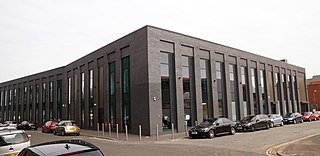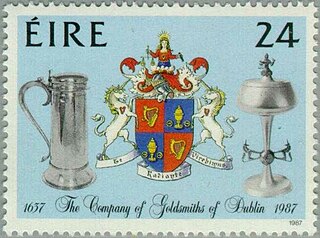
The Worshipful Company of Goldsmiths, commonly known as the Goldsmiths' Company and formally titled The Wardens and Commonalty of the Mystery of Goldsmiths of the City of London, is one of the Great Twelve Livery Companies of the City of London. The company's headquarters are at Goldsmiths' Hall, London EC2.
A hallmark is an official mark or series of marks struck on items made of metal, mostly to certify the content of noble metals—such as platinum, gold, silver and in some nations, palladium. In a more general sense, the term hallmark can also be used to refer to any distinguishing mark.

The Jewellery Quarter is an area of central Birmingham, England, in the north-western area of Birmingham City Centre, with a population of 19,000 in a 1.07-square-kilometre (264-acre) area.

The Birmingham Assay Office, one of the four assay offices in the United Kingdom, is located in the Jewellery Quarter, Birmingham. The development of a silver industry in 18th century Birmingham was hampered by the legal requirement that items of solid silver be assayed, and the nearest Assay Offices were in Chester and London. Matthew Boulton and Birmingham's other great industrialists joined forces with silversmiths of Sheffield to petition Parliament for the establishment of Assay Offices in their respective cities. In spite of determined opposition by London silversmiths, an Act of Parliament was passed in March 1773, just one month after the original petition was presented to Parliament, to allow Birmingham and Sheffield the right to assay silver. The Birmingham Assay Office opened on 31 August 1773 and initially operated from three rooms in the King's Head Inn on New Street employing only four staff and was only operating on a Tuesday. The first customer on that day was Matthew Boulton.
A Fabergé workmaster was a skilled craftsman who owned his own workshop and produced jewelry, silver or objets d'art for the House of Fabergé.

Louisa Perina Courtauld was a French-born English silversmith.

The Dublin Assay Office was established in 1637 to supervise the assaying of all gold and silver throughout the whole Kingdom of Ireland, when the Dublin Company of Goldsmiths was founded by royal charter, re-establishing the medieval Guild of All Saints.
Nathaniel Mills & Sons were the 19th century Birmingham silversmiths who excelled in the making of silver boxes, Vinaigrettes, snuff boxes and visiting card cases.

The House of Bolin is one of the oldest firms specialising in jewellery and silverware that remains in the hands of its founding family. The firm exists today as Jewellers and Silversmiths to HM the King of Sweden.

Henry George Murphy, aka H. G. Murphy was an English art-deco silversmith.

Evald Nielsen was a Danish silversmith and long-standing master of the Goldsmith's Guild of Copenhagen and one of the leading men behind the organizing of the Danish gold- and silversmiths.
Sara Jocelyn Margarita Elissa Burton was an award-winning British silver and goldsmith. Burton was the first woman to receive the City and Guilds of London Institute top award, the Prince Philip Medal.
The Goldsmiths' Company Assay Office in London is the oldest assay office in the United Kingdom. The company has provided hallmarking services since The Goldsmiths Company was founded in the 14th century. The company received its royal charter in 1327 and ranks fifth in order of precedence of the 12 great livery companies of the City of London.
Gilbert Leigh Marks was an English silversmith, who worked in the Arts and Crafts style, during a career of little over ten years.
Thomas Fattorini Ltd is a manufacturing jeweller and designer-maker of awards, trophies, ceremonial swords, civic insignia, medals and name badges. The company is located on three sites in Manchester, Birmingham and London with their head office in Skipton, North Yorkshire.

Reid & Sons is a firm of silversmiths founded in Newcastle upon Tyne in 1788 by Christian Ker Reid and which continues to trade today as part of the 'Goldsmiths Group'. In 2013 Reid & Sons celebrated its 235th anniversary. Over the years the various branches of the company have been known as Christian Ker Reid; Reid & Son; Reid & Sons; Reid & Sons Ltd; Craddock & Reid; William Ker Reid and Edward Ker Reid.
Joyce Rosemary Himsworth was a British independent designer silversmith. From an early age she worked with her father, the polymath Joseph Beeston Himsworth (1874–1968) making small spoons and items of jewellery. She went on to study at Sheffield College of Arts and Craft, focusing on jewellery manufacture and enamelling. Her undoubted talents were not enough for her to gain a position within the family cutlery firm, B. Worth & Sons.

Frederik Christian Vilhelm Christesen was a Danish goldsmith and silversmith. His firm was from 1858 based at Amaliegade 11 in Copenhagen.
Birte Stenbak née Jensen is a Danish goldsmith and jeweller. After an apprenticeship with Poul Bang in the 1950s, she worked in Bent Stålgård's workshop. In 1975, together with her friend Birthe Jørgensen, she established a studio and shop in central Copenhagen, where she created imaginative jewellery consisting of gemstones, silver, gold, pearls and other materials. From 1983, she ran the business alone in what became known as Aladdin's Cave. Collaborating with the artist Tage Andersen, in 1988 she created a large table decoration for Rosenborg Castle. Since the mid-1970s, her work has been exhibited at home and abroad.
Hamilton & Inches is a luxury jeweller and jewellery designer based in Edinburgh, Scotland. The company has held a royal warrant to the British monarch as goldsmiths, silversmiths, clock & watchmakers for over 120 years. The company's main headquarters are on George Street in New Town, Edinburgh. The company was founded by Sir Robert Inches and his uncle James Hamilton in 1866.









